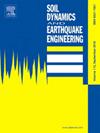Seismic response and failure mechanism of caisson: A centrifuge shake-table investigation
IF 4.2
2区 工程技术
Q1 ENGINEERING, GEOLOGICAL
引用次数: 0
Abstract
Past seismic events have shown that caisson quay walls are susceptible to severe damage during earthquakes, underscoring the importance of assessing their seismic behavior. However, very limited studies have been conducted on the soil-structure-water interaction of the caisson-ground system during earthquakes. This study will investigate the seismic response and failure mechanism of a caisson through a centrifuge shake-table test. Specifically, the seismic response results of the backfill, the caisson, and the subsoil are discussed; an acceleration integration method for identifying permanent displacement to estimate the backfill deformation is proposed; and a phase analysis of the seismic response of the caisson-ground system is conducted. It is found that the liquefaction of the backfill results in a substantial increase in the dynamic earth pressure behind the caisson. The failure mode of the caisson is lateral movement accompanied by slight tilting and continuous rocking vibrations. The proposed acceleration integration method can effectively estimate the deformation and lateral spreading of backfill. Phase analysis results reveal the relationship between the failure of the caisson-ground system and seismic action.
求助全文
约1分钟内获得全文
求助全文
来源期刊

Soil Dynamics and Earthquake Engineering
工程技术-地球科学综合
CiteScore
7.50
自引率
15.00%
发文量
446
审稿时长
8 months
期刊介绍:
The journal aims to encourage and enhance the role of mechanics and other disciplines as they relate to earthquake engineering by providing opportunities for the publication of the work of applied mathematicians, engineers and other applied scientists involved in solving problems closely related to the field of earthquake engineering and geotechnical earthquake engineering.
Emphasis is placed on new concepts and techniques, but case histories will also be published if they enhance the presentation and understanding of new technical concepts.
 求助内容:
求助内容: 应助结果提醒方式:
应助结果提醒方式:


